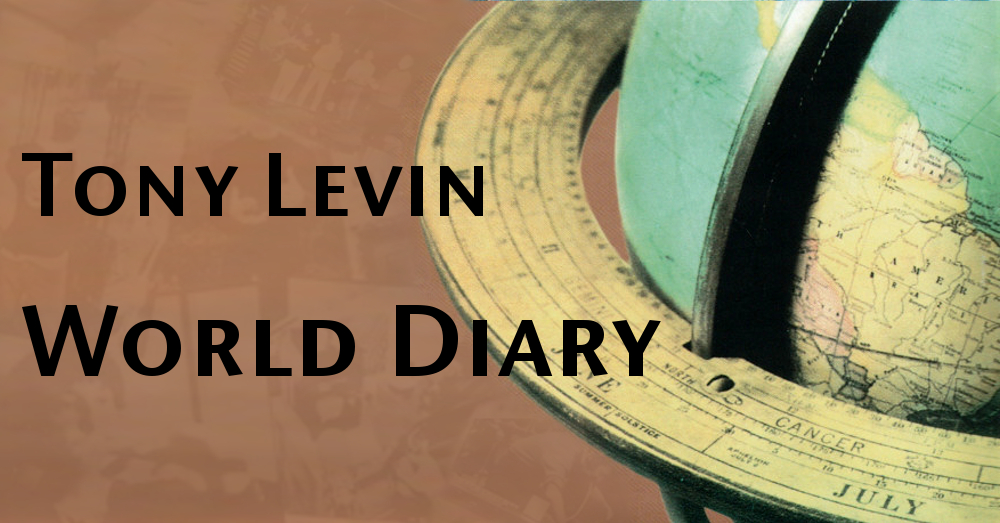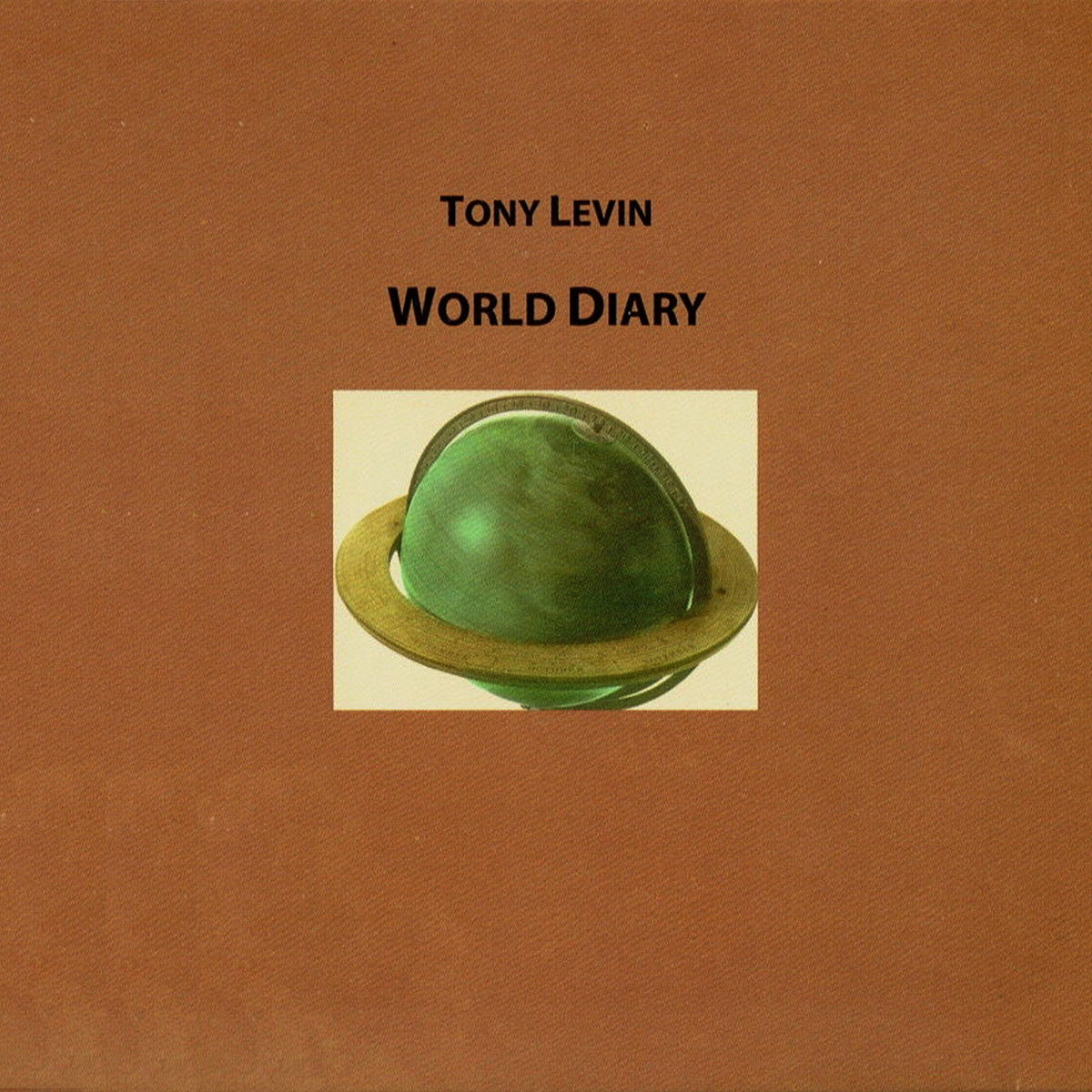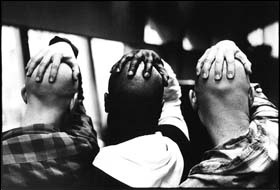


Tony Levin is the longest-serving member of Peter Gabriel’s band. He played on Gabriel’s first record and he still is in the band.
Levin was born in the United States in 1946 and lives there to this day. He attended the Eastman School of Music in Rochester. In 1968 he first played on a record and has appeared on more than 500 since then. While he used to play mainly jazz with acoustic and electric basses he was also booked increasingly for pop, folk and rock sessions. He got in touch with Peter Gabriel through producer Bob Ezrin who knew him from recording with Alice Cooper. Levin also took up playing the Chapman stick in the 1980s, and he occasionally plays the keyboards (e.g. live with Peter Gabriel), cello, tuba and also sings.
Tony Levin is also a member of King Crimson (from 1980 to this day, with interruptions) and formed his own band, Stick Men, in 2009.
World Diary is, incredibly, Tony Levin’s first solo album, and it was released on his own label Papa Bear Records. Two years before that Levin’s first song as a solo artist, Lone Bear, appeared on Plus From Us, a compilation to complement Peter Gabriel’s album Us. Lone Bear is not part of World Diary.
In a way, World Diary is a concept album, and the underlying concept is outlined in the album title. The record assembles songs Tony Levin recorded mainly on tour everywhere, sometimes even in hotel rooms. The audio quality is good despite that; in fact, it becomes warmer because of it. He was supported by a handful of musician friends, some of whom belong to the world music genre..
Tony Levin also like to take a number of photos on tour as well as keep a diary and published both of them: The photos are available in two volumes of illustrated books while you can read up on the tour diaries at his website.
 When he recorded World Diary, he did not have the website yet, and so it is in the booklet that we find many photos from “on the road” as well as bits of diary entries, fittingly written on hotel stationery.
When he recorded World Diary, he did not have the website yet, and so it is in the booklet that we find many photos from “on the road” as well as bits of diary entries, fittingly written on hotel stationery.
All this goes to show that what I have called a concept album is, musically, a conglomeration that contains neither the most modern sound nor songs that have been polished to perfect sophistication. The songs were played and/or written spontaneously, sometimes even improvised; some are merely vignettes. Levin is usually accompanied by only one or two musicians who are always credited. None of the musicians plays on more than two of the thirteen songs on the album.
The album begins hypnotically and threateningly with Chasm, which is a duet between a repeating stick riff and Shankar’s violin with some wordless vocals by Shankar (like Gabrielese). It sounds like a reduced version of Peter Gabriel’s Passion soundtrack.
On The Train is Levin playing with Ayub Ogada (Kenyan lyre and vocals), who also played on US. Sadly, Ogada died in February 2019. The song has no lyrics either, and though it is not, it sounds like traditional African music to Western ears.
The second half of the album contains another collaboration of Levin and Ogada called Nyatiti where Levin improvises against a repeating tune on the Kenyan lyre (the eponymous nyatiti); both tracks were recorded at Real World Studios.
We Stand In Sapphire Silence is ruled by the stick and a gently plucked koto; it is a bit closer to a song structure. Jerry Marotta adds Japanese percussion in the second half. This is a pleasant, calm song that would not be out of place in documentary about the Far East.
The final song on the album features the koto again. The Sound Of Goodbye has no percussion. According to the diary entry in the booklet, Koto player Brian Yamakoshi suggested playing this very slowly. The outcome is a lyrical, quiet album closer that lets you dream or, depending on your attention, fall asleep.
Smoke is one of two “songs” Levin recorded with Norwegian jazz saxophone player Bendik. At the end of the 1980s, both were members of the band Steps Ahead at the same (brief) time. This song as well as I Cry To The Dolphined Sea, see below) came about when Bendik did not take Levin to some lonely fjords when he visited Oslo, but stayed in the Norwegian capital that was overcrowded because of the Olympic Winter Games. In his book Beyond The Bass Clef, Tony Levin explains that this was just the introduction to the song proper. The rest of the material was used by Bruford Levin Upper Extremeties, so all we have here is a 50-second soundscape..
 The second track, I Cry To The Dolphined Sea, has normal length and additional drum overdubs by Jerry Marotta. The saxophone becomes the leading instrument. The guitar strings of the Chapman Stick follow it (and sound like a guitar synthesizer at times), while the bass strings make up a cool, somewhat inaccessible basic rhythm.
The second track, I Cry To The Dolphined Sea, has normal length and additional drum overdubs by Jerry Marotta. The saxophone becomes the leading instrument. The guitar strings of the Chapman Stick follow it (and sound like a guitar synthesizer at times), while the bass strings make up a cool, somewhat inaccessible basic rhythm.
After Smoke, the Etude In The Key Of Guildford is a collaboration between Levin and Bill Bruford (on electronic drums) that was recorded, like Jewels, at Bill Bruford’s home in … Guildford! It is exactly what you would image when you think about Bruford’s drums and Levin’s stick play. It resembles some King Crimson moments from the 1980s, but it is not really a composed song.
Jewels seems to be an extended version of Evensong from Yes’s album Union. Tony Levin played bass on some songs of that album, namely on those that would become a new Anderson Bruford Wakeman Howe album. This shows that some of Levin’s recordings are older, for Union came out in 1991. Jewels is another soundtrack candidate that is nothing like King Crimson. The electronic drums resemble a glockenspiel, while the melodious stick play in the beginning and at the end might almost be the distorted sound of a cello.
Espresso & The Bed Of Nails is another track without world music sounds. Its mood changes in abruptly from claustrophobic to crimsonesque. Levin plays with the Canadian percussion group Nexus, creating one of the most exciting tracks on the CD. He knew some of their members because they attended Eastman together. According to the booklet, this is a shortened version, though I am not aware that a complete version has ever been released anywhere.
The second track from this collaboration is called Heat. At six-and-a-half minutes it is the longest track on the album. The Stick is the governing instrument here; it switches between mellifluous, monotonous and aggressive sounds. The percussion provides only a background and help Levin to create a mood for performing this complex song.
 Levon Minassian plays the doudouk on track 7, Mingled Roots. Fans of King Crimson may know it from the compilation Sometimes God Hides: The Young Person’s Guide To Discipline that contains an edited version. This track fits in well with the world-music influence of Peter Gabriel’s Us period, though Levin’s bass is very distorted in places.
Levon Minassian plays the doudouk on track 7, Mingled Roots. Fans of King Crimson may know it from the compilation Sometimes God Hides: The Young Person’s Guide To Discipline that contains an edited version. This track fits in well with the world-music influence of Peter Gabriel’s Us period, though Levin’s bass is very distorted in places.
La Tristesse Amoureuse De La Nuit is another highlight of the album because it features Levon Minassian as well as Manu Katché on drums. This track would have fit on Levin’s later solo albums as well. It has a vaguely Oriental feeling because of the doudouk alongside rather weird improvisations on bass and drums with a jazz impression. This is the most progressive recording on World Diary in traditional terms.
Tony Levin gives us a very diversified album that has not much to do with pop nor with progressive rock. It shows a side of himself the Gabriel fan is unlikely to know and it picks up on what he does with Stick Men and various other projects.
If you do not mind world music influence, enjoy improvised music and are not annoyed by lots of Stick and bass, you will come to enjoy the varied and atmospheric sound of World Diary very much.
